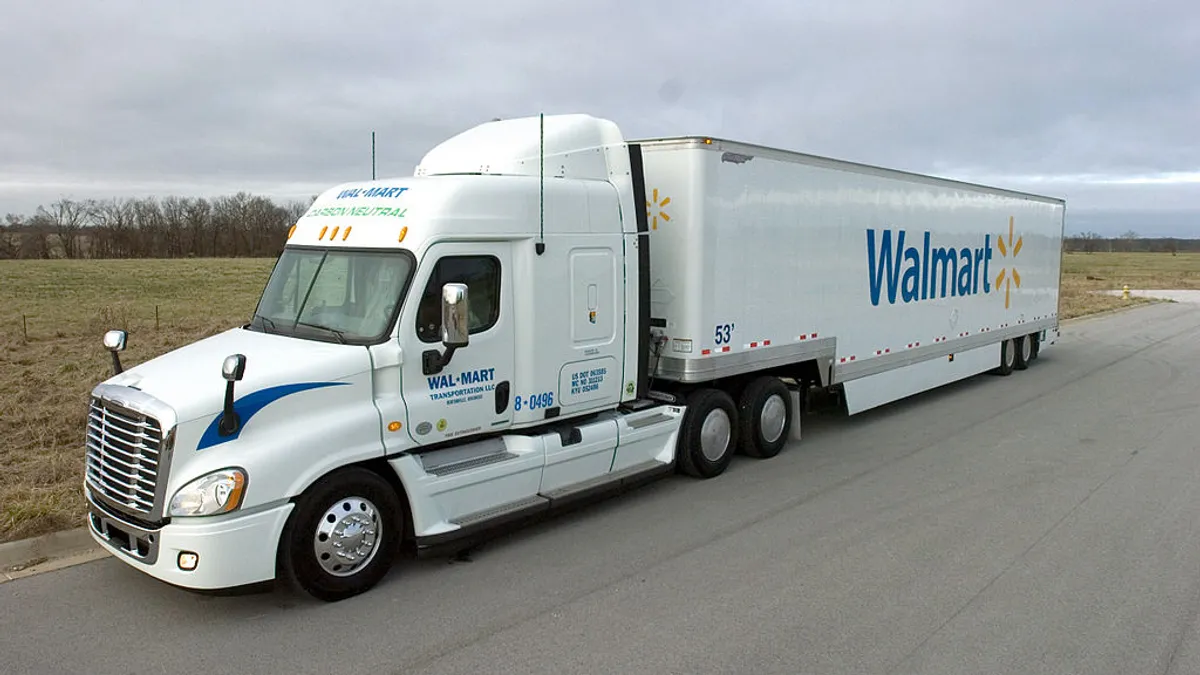Dive Brief:
- Walmart, who has historically had low trucker turnover, is being pinched by the worsening shortage of drivers across the U.S. The retailer plans to double its spending on enticing and retaining truckers by the end of the year, according to Bloomberg Business.
- In an effort to attract more drivers amid the tight market, Walmart will offer referral bonuses of up to $1,500, reduce the onboarding process by more than a month and broadcast its first national TV ad to drum up recruits.
- “To be candid, right now I could hire a few hundred drivers,” Tracy Rosser, Walmart’s senior vice president of transportation, told Bloomberg. “It is getting tougher and tougher to find qualified drivers. It’s a really serious situation right now.”
Dive Insight:
Transportation is an issue in the grocery industry. With wage hikes, rising diesel-fuel prices and higher freight demand, June saw the biggest monthly uptick in long-distance trucking costs in nearly a decade.
On top of the rising costs, driver vacancies reached a record 296,311 in the second quarter, according to researcher FTR Transportation Intelligence. Just one truck was available for every 12 loads needing to be shipped at the start of 2018, which is the lowest ratio since 2005, according to an industry analysis by DAT Solutions.
The average age of a Walmart driver is 55, so the company is losing many to retirement, and the industry turnover rate hovers around 90 percent for long-haul truckers, according to the American Trucking Associations. In an effort to fill the gaps left by truckers rotating and retiring, Walmart is vigorously increasing incentives. New hires earn about $86,000 a year and get up to three weeks vacation, and now Walmart is working to reduce the onboarding process from 70 to 30 days and offering referral bonuses to new drivers.
Walmart’s profit margins have taken a hit for three straight quarters due to the trucker shortage. But the company is not alone. Bloomberg reports that cutthroat competition has caused some other carriers to raise wages as many as three times over the past year and dish out signing bonuses of as much as $10,000. Everyone is feeling the strain.
With shipping costs rising and freight volumes outpacing the supply of available trucks, food distributors are scrambling to find a solution to slow the financial burden on their overall earnings. Many manufacturers — including Dean Foods, Tyson, Del Monte, Kellogg and US Foods — said higher transportation and logistics costs weighed on earnings in the most recent quarter.
Trucks are vital to the retail supply chain. They carry more than 70% of the goods consumed in this country, according to the American Trucking Association, and under normal circumstances, grocers lose $75 billion a year in sales — 10% of the industry total — due to out-of-stocks and unsalable goods, often the result of late deliveries, according to the Food Marketing Institute. With the industry anticipating a need for 898,000 new drivers or an average of nearly 90,000 per year for the next decade, if fleets can’t find new drivers, grocers could expect losses to increase. As it stands, it wouldn’t be surprising to see retailers and manufacturers pass the cost of those losses on to consumers.
But to contrast that, diesel prices are expected to drop after reaching a three-year high. Although lower gas prices alone won’t be enough to overcome the worker shortage, it could help financially. The demands of the job are steep, even with recent regulations limiting time on the road, and keep many otherwise qualified drivers from applying. The hours are long and don’t allow for much of a home life. In addition, it’s a largely male field, with only 6% women in its workforce.
Still, Walmart hopes that by doubling its recruiting spend for non-traditional truckers that it can operate its private fleet of 6,500 trucks at full capacity and keep fulfilling orders. However, the pressures associated with freight show no signs of letting up, and as the perfect storm of higher consumer demand and lower trucking supply continues to rage, it will keep having a significant impact on profit margins for retailers and suppliers.








